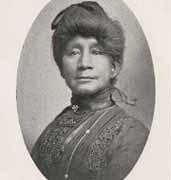Mrs. "Hester C." R.
Jerome Jeffrey
|
Hester C. Jeffrey moved to Rochester, New
York from Boston, Massachusetts in 1891. She was the daughter-in-law
of Reverend Rosewell Jeffrey, an affluent and prominent political
activist and the wife of R. Jerome Jeffrey. (She was sometimes
referred to as Hester Jeffreys or Hester Jeffries.)
Jeffrey, an untiring organizer and an activist
in her own right, became involved in many of the city's associations
soon after she moved to Rochester. She was a member of the Political
Equality Club and the Women's Christian Temperance Union (WCTU).
In the latter group she held the positions of County Superintendent
as well as Secretary of the Third Ward WCTU. She was also Section
President of the Needlework Guild of America. In 1897, she was
appointed to serve on the (Frederick) Douglass Monument Committee.
|
click picture to enlargen
 |
Jeffrey founded or helped to organize a number
of local African-American women's clubs among the growing black
community in Rochester. In 1902, she organized the Susan B. Anthony
Club for African-American women. She also served as its president.
While the club's goals were in part philanthropic -- its Mothers'
Council was created to help mothers with small children - -it
also advocated suffrage, as its name implies.
Jeffrey was also instrumental in founding the
Climbers and the Hester C. Jeffrey Club, organizations for young
African-American women. One of the purposes of the Hester C. Jeffrey
Club was to raise funds for young black women to take courses
at the Mechanics' Institute (which later became the Rochester
Institute of Technology).
As the above affiliations demonstrate, Jeffrey
built and maintained ties across racial communities in Rochester.
Her affiliations with both communities are reflected in the religious
sphere as well as in civic and philanthropic organizations. While
she often attended the First Unitarian Church and had close ties
with Mary Gannett, wife of its prominent minister, she maintained
an active membership in the African Methodist Episcopal (A.M.E.)
Zion church, and served on various committees there.
Jeffrey's activities as a clubwoman assured
her a state and national as well as a local presence. In 1902,
she spoke at a Buffalo, New York convention of the National Association
of Colored Women (NACW), a group founded in 1896 by such prominent
African-American leaders as Harriet Tubman, Rosetta Douglass Sprague
(daughter of Frederick Douglass), Frances Harper, Mary Church
Terrell and Ida Wells Barnett.
In 1905, Jeffrey represented the New York Federation
of Colored Women (NYFCW) at a New York State Woman Suffrage Association
(NYSWSA) convention. The same year, as president of the NYFCW,
she presented its annual report when the group met in Rochester.
Jeffrey was also a friend and associate of
Susan B. Anthony, and was chosen to give a eulogy at Anthony's
funeral, in 1906. There, she shared the platform with William
Channing Gannett (minister of the Unitarian Church), Rochester
Mayor James Cutler, Rush Rhees (president of the University of
Rochester), and nationally known suffragists Carrie Chapman Catt
and Reverend Anna Howard Shaw. Jeffrey's eulogy reflects her many
affiliations and activities:
We, the colored people of Rochester, join
the world in mourning the loss of our true friend, Susan B. Anthony....The
colored churches in this city, the National and State Federations
of Colored Women, the federated clubs of the association...all
extend...their tender sympathy...."
In her eulogy, Jeffrey also expressed her support
and advocacy for suffrage. She stated that the "members of
the Susan B. Anthony Club" were filled with "sorrow"
for the loss of "their great leader." She proclaimed
Anthony to be a "friend for many years -- our champion."
And she "pledge[d]" that the members of the Club would
"devote our time and energies to the work thou has left us
to do."
Jeffrey was instrumental in the establishment
of the first memorial for Susan B. Anthony. The memorial, a stained
glass window at the A.M.E. Zion church, consisted of a portrait
of Anthony along with her famous statement -- "Failure is
Impossible." It was presented to the church by Jeffrey on
behalf of the Susan B. Anthony Club. Unveiled on August 20, 1907,
the occasion was commemorated with speeches by suffragist Jean
Brooks Greenleaf and Hannah B. Clark.
Hester Jeffrey organized and led associations
that improved the lives of African-American women in Rochester.
She was also able to transcend racial barriers at a time when
this was no small feat. She joined forces with the suffrage movement
and, as author Roslyn Terborg-Penn states, was able to move between
the often-segregated worlds as part of "both the NACW and
the NAWSA [National American Woman Suffrage Association] networks."
Hester Jeffrey died in 1931.
references:
- http://winningthevote.org/HJeffreys.html
- McKelvey, Blake, "Lights and Shadows
in Local Negro History," Rochester History, v. 21,
no. 4 (October 1959), p. 18.
- http://www.newyorkgenealogy.org/bios.htm
- http://www.rrlc.org/wsdp/suffragists.html
